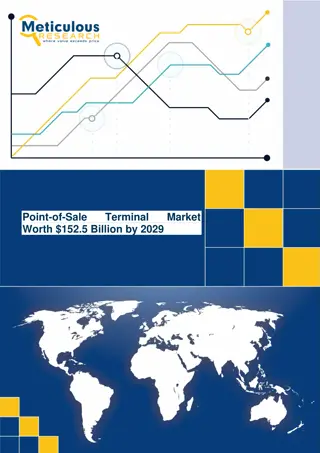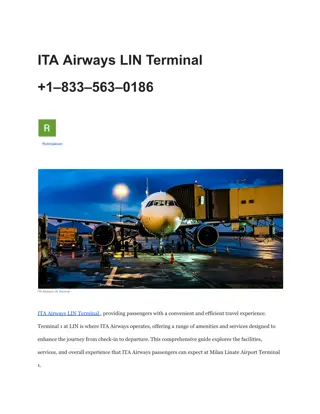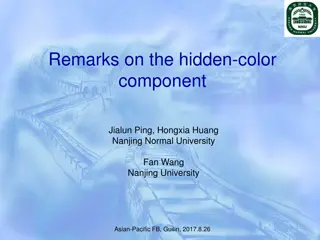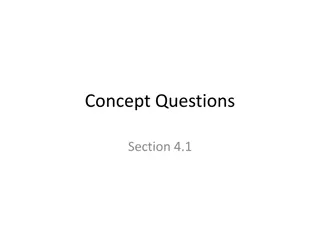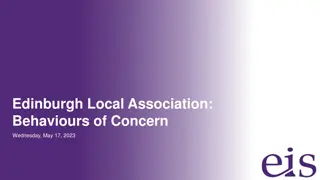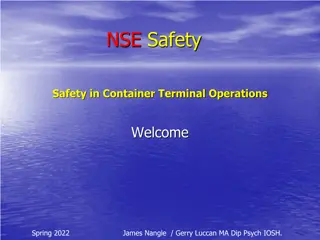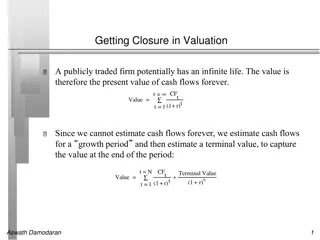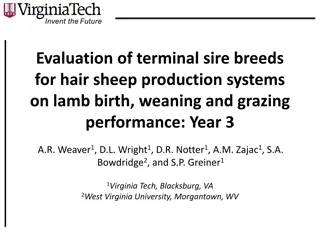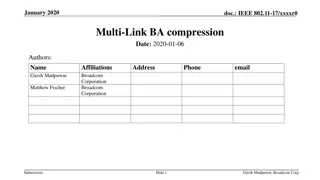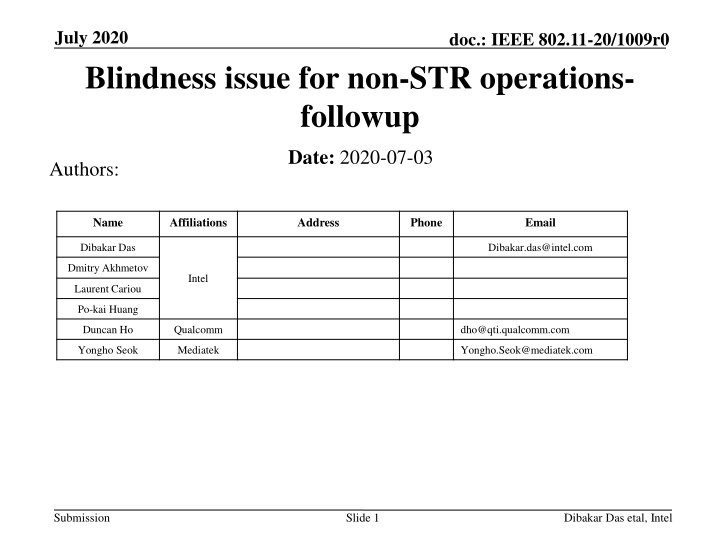
Blindness Issue in Non-STR Operations Follow-Up
Follow-up document discussing the blindness issue during transmission of ML in non-STR operations as per IEEE 802.11-20/1009r0, presenting solutions and proposed strategies for addressing the hidden node problem.
Download Presentation

Please find below an Image/Link to download the presentation.
The content on the website is provided AS IS for your information and personal use only. It may not be sold, licensed, or shared on other websites without obtaining consent from the author. If you encounter any issues during the download, it is possible that the publisher has removed the file from their server.
You are allowed to download the files provided on this website for personal or commercial use, subject to the condition that they are used lawfully. All files are the property of their respective owners.
The content on the website is provided AS IS for your information and personal use only. It may not be sold, licensed, or shared on other websites without obtaining consent from the author.
E N D
Presentation Transcript
July 2020 Blindness issue for non-STR operations- followup doc.: IEEE 802.11-20/1009r0 Date: 2020-07-03 Authors: Name Affiliations Address Phone Email Dibakar Das Dibakar.das@intel.com Dmitry Akhmetov Intel Laurent Cariou Po-kai Huang Duncan Ho Qualcomm dho@qti.qualcomm.com Yongho Seok Mediatek Yongho.Seok@mediatek.com Submission Slide 1 Dibakar Das etal, Intel
July 2020 doc.: IEEE 802.11-20/1009r0 Abstract Follow up on the blindness issue during Tx of ML Submission Slide 2 Dibakar Das etal, Intel
July 2020 doc.: IEEE 802.11-20/1009r0 Introduction We have agreed to allow non-STR operation in SFD: 802.11be shall allow a MLD that has constraints to simultaneously transmit and receive on a pair of links to operate over this pair of links Signaling of these constraints is TBD. When non-STR STA is txing in link-1 it may miss frames transmitted on link 2. As a result, when the transmission is over, the STA may falsely detect medium in link 2 to be idle (e.g., if the RSSI is between -82 and -62 dBm) and transmit during an ongoing activity on the other link => hidden node problem due to non-STR operation. BA (RA: STA1) DATA (TA: STA1, RA: AP1) RTS (TA: STA1, RA: AP1) CTS (RA: STA1) AP 1 STA 1 Link 1 Non-AP MLD 1 Link 2 (from STA-2 perspective) STA 2 RTS (TA: STA2) time AP 2 Link 2 (from STA-3 perspective) RTS (TA: STA3) CTS (RA: STA3) DATA (TA: STA3, RA: AP2) Non-AP MLD 2 STA 3 : STA-2 not blind AP MLD : STA-2 blind Collision at AP 2 Submission Slide 3 Dibakar Das etal, Intel
July 2020 doc.: IEEE 802.11-20/1009r0 Background (NAVsyncdelay) For other STAs on the same channel, the impact of non-STR STA coming out of blindness and performing channel access is similar to the case of STA coming out of Doze to awake and doing the same. Currently, the spec proposes to use the NAVSyncDelay timer to solve this problem for Doze-to-Awake transitions. The timer value is set by non-AP STA. The usage is defined in REVmd as: A (11ah)non-S1G STA that is changing from doze to awake state in order to transmit shall perform CCA until a frame is detected by which it can set its NAV, or until a period of time indicated by the NAVSyncDelay from the MLME-JOIN.request primitive has transpired. The usage in 11ax is limited to SST operation. Typically the NAVSyncDelay value is set by STA to be zero. This does not cause significant problems because the STA does not go from Doze to Awake frequently. For non-STR operation we expect higher frequency of such transitions. Submission Slide 4 Dibakar Das etal, Intel
July 2020 doc.: IEEE 802.11-20/1009r0 Recap of solutions proposed In 490r0 we analyzed the problem and proposed a solution to address it mainly from the associated BSS perspective. After blindness is over, STA refrains from transmitting for some timer value (similar to NAVSyncDelay) except for 1 RTS frame. Concurrently in 444r1, two options were presented to address the problem from overall network perspective. Option 1: Similar to NAVSyncDelay, start a fixed timer during which countdown is prohibited. It expires after decoding preamble and/or NAV. Option 2: Lower ED level after transmission to -82 dBm. Tx Rx STA 1 Example of option 1 solution in 444r1. Countdown_ prohibit timer = aPPDUMaxTime Busy Tx Rx STA 2 Can start countdown again here Submission Slide 5 Dibakar Das etal, Intel
July 2020 doc.: IEEE 802.11-20/1009r0 Revised solution The solution in 490r0 prioritizes non-STR STA MLD performance while that in 444r1 is more protective of the network performance. To balance the two requirements we propose a joint solution: Every non-STR STA start a timer, following the end of a transmission on the other link except in some cases where it is assumed to have the medium state information (see next slide). The value of this timer can be specified in spec or configured by AP. While the timer is running, STA can do EDCA using baseline CCA but a TBD ED threshold value (e.g., between -62 and -82dBm) whose value can be configured by AP; otherwise set to some default value (e.g., -62dBm). The first frame after EDCA countdown is an RTS frame; the max number of RTSs that STA can transmit while timer is running is configured by AP (at least 1) The timer expires early if at least either of the following events happens: any received PPDU with a valid MPDU (including response CTS to any txmitted RTS) a received PPDU with a valid TxOP_duration Submission Slide 6 Dibakar Das etal, Intel
July 2020 doc.: IEEE 802.11-20/1009r0 Revised solution (contd.) Medium state information is assumed to be known if STA-2 just transmitted PPDUs with end-time alignment on both links. SIFS DATA (TA: AP1, RA: STA1) BA (RA: AP1) AP 1 STA 1 Link 1 Non-STR Non-AP MLD 1 STA-1 and 2 resume regular EDCA BA (RA: AP2) DATA (TA: AP2, RA: STA2) SIFS Link 2 AP 2 STA 2 time AP MLD Medium state information is also assumed to be known if the NAV counter is non-zero at the end of transmission. BA (RA: STA1) DATA (RA: AP1, TA: STA1) SIFS AP 1 STA 1 Link 1 Non-STR Non-AP MLD 1 NAV duration set from CTS Link 2 RTS (TA: STA3) CTS (RA: STA3) AP 2 STA 2 STA-2 does not start timer at end of STA-1 tx time AP MLD Submission Slide 7 Dibakar Das etal, Intel
July 2020 doc.: IEEE 802.11-20/1009r0 Example of proposed solution BA (RA: STA 1) DATA (TA: STA1, RA: AP1) RTS (TA: STA1, RA: AP1) CTS (RA: STA1) Link 1 AP 1 Non-AP MLD 1 STA 1 Timer expires EDCA at TBD ED threshold Link 2 RTS (TA: STA2, RA: AP2) CTS (RA: STA2) AP 2 STA 2 time Initial timer duration : STA-2 not blind : STA-2 blind Submission Slide 8 Dibakar Das etal, Intel
July 2020 doc.: IEEE 802.11-20/1009r0 Revised Solution (contd.) The proposed solution only addresses the typical cases but does not attempt to resolve every possible blindness issue especially some that are naturally present in single link operation. For example, if the STA missed any frame (e.g., new frame) during blindness that updates existing NAV information then it may still operate based on old NAV value. This is equivalent to STA missing frames due to collision that updates NAV. Submission Slide 9 Dibakar Das etal, Intel
July 2020 doc.: IEEE 802.11-20/1009r0 Summary Proposed a simple solution to resolve non-STR MLO blindness for typical cases that attempt to find a balance from STA perspective and BSS perspective. Submission Slide 10 Dibakar Das etal, Intel
July 2020 doc.: IEEE 802.11-20/1009r0 SP text Do you support that if during a transmission of a STA (STA-1) of a non-STR non-AP MLD, another STA (STA-2) of the same MLD cannot detect its medium state when required (due to STA-1 s UL transmission interference), STA-2 shall start a MediumSyncDelay timer at the end of the transmission, unless the STA-2 has a non-zero NAV value or the STA-2 ended a transmission at the same time: the MediumSyncDelay timer expires after a duration value that is either assigned by AP or specified in spec or if at least either of the following events happens: any received PPDU with a valid MPDU a received PPDU with a valid TxOP_duration whichever happens first while the MediumSyncDelay timer is running the STA is only allowed to attempt to initiate up to number of TxOPs assigned by the AP (at least 1) and shall attempt to initiate that TxOP with the transmission of an RTS frame using regular EDCA backoff using baseline CCA but a TBD ED threshold value Note: The TBD ED threshold value has a default value specified in the spec (e.g., -62dBm) but can also be assigned by the AP MLD within a limited range such as between -82dBm and - 62dBm Slide 11 Submission Dibakar Das etal, Intel
July 2020 doc.: IEEE 802.11-20/1009r0 References 11-20-044r1-MLA: Non-STR STA Behaviors 11-20-490r0-Impact of channel blindness during ML Submission Slide 12 Dibakar Das etal, Intel



